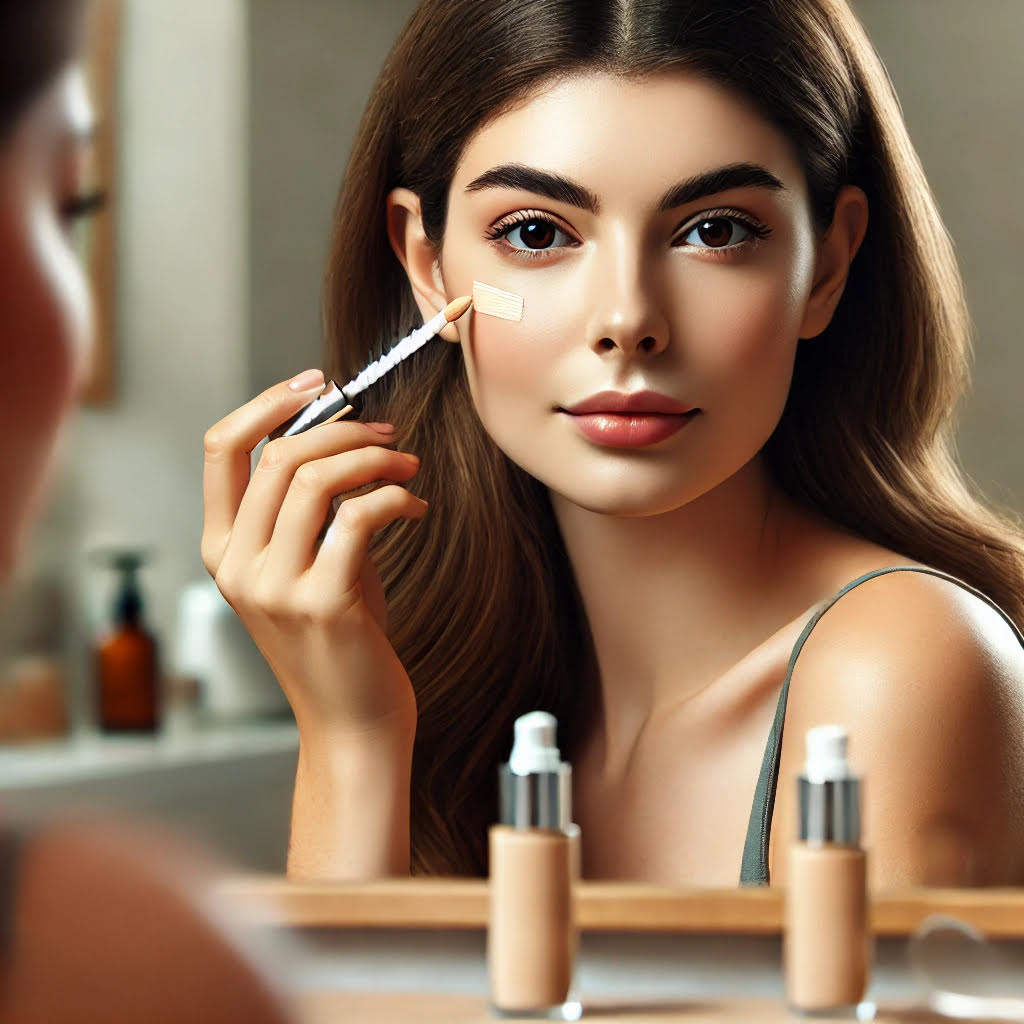Concealer is a must-have in any makeup routine, offering essential coverage for blemishes, dark circles, and other imperfections to achieve a flawless complexion. Even when you have no concealer available, its role in creating a polished look can’t be overstated.
But what happens when you run out of concealer and need a quick fix? It’s a common scenario that can leave you scrambling for a solution. Fortunately, you don’t have to panic.
There are several everyday household or makeup items that can step in as effective substitutes. With a little creativity, you can still achieve the flawless skin you desire, even without your trusty concealer.
1. Foundation as a Substitute
Foundation can be an effective substitute for concealer by building up coverage in targeted areas. With careful application, it can conceal blemishes, dark circles, and other imperfections.
To use it, apply a thicker layer of foundation on problem areas using a dense brush or your fingers. Focus on blemishes or under-eye circles, gently blending the edges to ensure a seamless finish.
For extra coverage, mix your foundation with a small amount of setting powder before applying. This will help the product adhere better and provide longer-lasting results.
2. BB or CC Cream
BB or CC cream can be a quick and effective alternative when you’re out of concealer. These creams offer buildable coverage, allowing you to focus on areas that need extra attention, like under the eyes or over blemishes.
To use, simply apply a small amount to the areas you’d typically conceal and blend it out with your fingers or a sponge for a natural finish. For added coverage, mix your BB or CC cream with a touch of foundation to create a custom, concealer-like consistency.
BB cream is particularly versatile, as it not only hydrates but also adds a beautiful radiance to the skin, making it a perfect choice for those with dry skin. Meanwhile, CC cream provides lighter coverage with a matte finish, making it ideal for oily skin.
Celebrity makeup artist Nydia Figueroa from Cedar Grove, New Jersey, highlights that these creams can be tailored to your skin type and desired look, serving as a reliable stand-in for concealer when you need it most.
3. Lip Balm or Vaseline with Foundation
Lip balm or Vaseline mixed with foundation can serve as a creative substitute for concealer, offering a creamy and hydrating texture. This combination can help create a dewy, radiant finish while also providing coverage.
Start by dabbing a small amount of lip balm or Vaseline onto the areas you want to conceal, such as under the eyes or over blemishes. Next, apply foundation over the top and gently tap it in to blend the two products together. This technique allows you to achieve a smooth, even coverage with added moisture.
This method is especially beneficial for dry skin, as the lip balm or Vaseline helps to hydrate and create a glowing effect. However, be mindful of using too much product, as it can become greasy or shift throughout the day. Adjust the amount based on your skin’s needs and blend well to ensure a natural, seamless look.
4. Eyeshadow Primer
Eyeshadow primer, typically used to even out the skin tone on the eyelids, can be a handy substitute when you have no concealer. Its formulation helps to create a smooth base and can be applied to other areas of the face in need of coverage.
Apply a thin layer of eyeshadow primer to blemishes or under the eyes where you would normally use concealer. Blend it gently with your foundation to achieve a seamless look.
For the best results, choose an eyeshadow primer that closely matches your skin tone. This ensures a more natural appearance and enhances the overall effectiveness of the coverage.
5. Tinted Moisturizer
When you find yourself with no concealer, tinted moisturizer can be an excellent alternative. It offers light coverage and can be layered for additional effect, helping to address imperfections and even out your skin tone.
Apply tinted moisturizer to the areas where you need coverage, such as blemishes or dark circles. Build up the coverage by layering the product and blending thoroughly to achieve a more polished look.
Tinted moisturizers are ideal for those who prefer a dewy finish. They provide hydration and a radiant glow, making them a great choice for a fresh, natural appearance.
6. Color Corrector Without Concealer
If you find yourself with no concealer, color correctors can be a valuable alternative for achieving a more even complexion. While color correctors are typically used as a first step before applying concealer and foundation, they can still be quite effective on their own in neutralizing discoloration.
To use a color corrector without concealer, start by selecting the right shade for your needs. For dark circles under the eyes, a peach or orange corrector can help counteract the blue or purple tones. For redness, such as that caused by blemishes or irritation, a green corrector can neutralize the color effectively.
Apply a small amount of the corrector to the problem areas, gently blending it into the skin. Once blended, layer foundation or powder over the top to even out your complexion and set the look.
For the best results, make sure to blend the corrector thoroughly to avoid any visible color streaks or patches. This approach allows you to address discoloration and achieve a smoother, more balanced appearance even when you have no concealer on hand.
7. Cream Blush or Lipstick
Cream blush or lipstick can serve as a handy alternative to concealer, especially for addressing dark circles and other areas of discoloration. Both products can provide the needed coverage and help brighten the skin.
To use cream blush or lipstick as a concealer substitute, start by choosing a peachy or reddish shade. These colors are effective at countering dark circles due to their color-correcting properties. Dab a small amount of the blush or lipstick gently under your eyes or on the areas of discoloration.
Blend the product carefully to ensure it merges well with your skin. Once the initial layer is blended, follow up with foundation to even out the overall appearance. This method can help neutralize dark circles and provide a fresh, radiant look, making it a useful trick when you have no concealer available.
8. Setting Powder Alone
When you have no liquid or cream product available, setting powder can be a practical alternative. Although it doesn’t offer the same level of coverage as concealer or foundation, it can still help reduce shine and slightly blur imperfections.
To use setting powder as a substitute, start by applying it with a dense brush. Gently press the powder onto blemishes or under the eyes, focusing on areas where you want to minimize shine and create a smoother appearance.
Pro Tip: Setting powder is particularly effective for those with oily skin, as it helps control excess oil and maintain a matte finish throughout the day. While it won’t completely cover imperfections, it can improve the overall look of your skin and provide a more polished finish in the absence of other products.
Conclusion
In conclusion, running out of concealer doesn’t mean you have to compromise on your makeup routine. With these creative alternatives, you can achieve a polished look even when you have no concealer on hand. Experiment with options like foundation, BB or CC creams, and color correctors until you’re able to restock your concealer.
Remember, makeup is an opportunity to express your creativity, so have fun and make the most of what you have available! If you’ve tried any of these alternatives or have other tips to share, leave a comment below, we’d love to hear from you!

